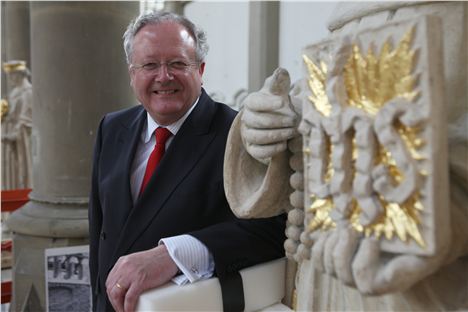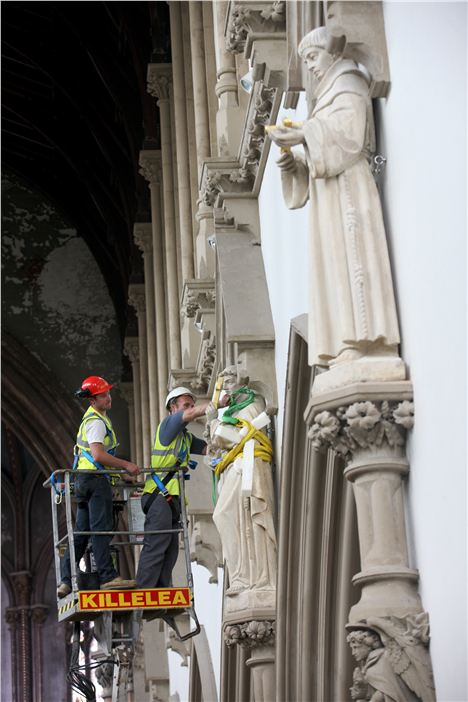AFTER more than sixteen years in storage, and eight months being carefully restored, twelve saints’ statues have been hoisted 40 feet up onto their plinths in the nave at Gorton Monastery.
It is enormously exciting to see them restored and ready to be put back in their rightful place in this beautiful building.
Since September 2011 two local artists, Shawn Williamson and Andrew Scantlebury, both specializing in sculpture and stone masonry, together with a group of volunteers, have been painstakingly restoring and cleaning the stone statues on-site in two container workshops.
Made of French limestone, each statue is eight feet in height and weighs half a ton.
Sculptor Shawn Williamson explained: “We had to work in the style of the original sculptors from 150 years ago. One of my favourite parts of the job was replacing St Clare’s missing nose. The statues were designed to be viewed from the ground, not from in front. The lips protrude a lot, but that’s just part of the exaggeration of the features so that they can be seen clearly from the ground. Her nose had to be shaped in the same way.”
Andrew Scantlebury added: “It has been a challenging project, but it’s been great. I would love to do it all over again. In some ways it’s a shame it has come to an end, but I’ll be immensely happy and proud to see the Saints back where they belong.”
After the sculptors had finished parts of each statue was gilded. Specialist gilder, Terry Colley, from Romiley near Stockport was brought in to complete the work. Terry had to wait until all the dust had settled from carving the stone, then several coats of sealant were applied to each statue to seal the porous material. The final stage was the application of 23 carat gold leaf.
Terry Colley, describing how he approached this task said: “It was important not to gild the statues too much, to respect the Franciscan vow of poverty. I feel a good balance between the aesthetic and religious influences was reached.”
Some of the replacement parts were carved in wood. Simon Young, a longstanding and committed volunteer at the Monastery recreated a cross for St Bonaventure and a crozier for Louis of Toulouse. He explained: “I worked from original photographs taken when the Saints were in-situ, and although they were a bit woolly and grainy, they gave a good idea of what the pieces looked like and the proportions. For the crozier I also looked on the internet at images of similar ones, before carving it in pine.”
A team of four from a Rossendale based company, Killelea, structural steelwork specialists and experts in lifting, had the delicate task of hoisting the statues back onto their plinths.
Elaine Griffiths, chief executive of The Monastery said: “It is of particular significance to The Trust that the Saints are returning in the 150th anniversary year of The Monastery. The statues have always been regarded as an integral part of the buildings’ architecture and have been noticeably missing from their plinth. It is enormously exciting to see them restored and ready to be put back in their rightful place in this beautiful building. This concludes another successful chapter in the restoration and reinvention of The Monastery.”
 Paul Griffiths, chair of the Monastery trust, and the gilding
Paul Griffiths, chair of the Monastery trust, and the gilding
The backstory
The Monastery statues had been removed in the early 1990s by a developer who intended to convert the buildings into flats. When the scheme failed The Monastery was abandoned and quickly fell into disrepair, at the mercy of vandals, thieves and inclement weather.
A local historian, Janet Wallwork, saw the Saints in a catalogue for an auction at Sotheby’s in 1994, sparking an investigation into their ownership and how they came to be for sale at all. Sir Gerald Kaufman, MP for Gorton, helped with negotiations for their removal from the auction and Manchester City Council stepped in to buy the statues, saving and protecting an important part of the city’s architectural heritage, at a cost of £25,000.
The statues are of the following Franciscan saints:
St Clare of Assisi, Visionary who was the first female follower of St Francis. Patron of television, telecommunications, eye complaints, needleworkers and goldsmiths. Feast Day - August 11th.
St Louis of Toulouse A Prince related to St Elizabeth and St Louis, who renounced all his wealth and royal position to follow St. Francis. Feast Day - August 19th.
St Berard Nobleman, scholar and preacher, who became a missionary, and was the first Franciscan martyr. His death inspired St Anthony of Padua to join the Order. Feast Day - January 16th.
St Elizabeth of Hungary Queen dedicated to helping the poor. Patron of charities, hospitals, exiles, the homeless, bakers and lace-makers. Feast Day - November 17th.
St Leonard of Port Maurice, Famous preacher who promoted devotion to the Blessed Sacrament, the Sacred Heart, the Stations of the Cross and the Immaculate Conception. Patron of Italy. Feast Day - November 26th.
St Didacus Penitent, hermit and miracle worker; patron of Franciscan lay brothers, and of the Philippines. Feast Day - November 13th.
St Ivo of Brittany Incorruptible lawyer who defended the poor, and later became a priest. Patron of lawyers, barristers, judges, abandoned children and Brittany. Feast Day - May 10th.
St Peter of Alcantara Preacher, mystic, visionary and reformer. Patron saint of night watchmen, adorers of the Blessed Sacrament and Brazil. Feast Day - October 22nd.
Saint Louis, King of FranceThe only canonized King of France and a great patron of the arts. Patron of prisoners, builders, sculptors, soldiers, hairdressers, and Franciscan Tertiaries. Feast Day - August 25th.
St Bernadine of Siena Famous preacher who promoted devotion to the Holy Name. Patron of advertising, communications, compulsive gamblers and those with throat, lung and chest complaints. Feast Day - May 20th.
St Bonaventure Mystic, theologian and philosopher who became a Cardinal and a Doctor of the Church. Patron of scholars, and those with bowel disorders. Feast Day - July 15th.
St Anthony of Padua Famous orator. Patron of the poor and oppressed, travellers, sailors, fishermen and of lost items, mail and domestic animals. Feast Day - June 13th
Gorton Monastery historical background information
Edward Pugin, one of the leading architects of the day and whose father Augustus was the architect for the Houses of Parliament, was commissioned to design and build the imposing church and friary on Gorton Lane by the Franciscans in 1863.
The Franciscans left the site in 1989 and after a failed attempt by a developer to convert the buildings into apartments, the building was finally handed over to the care of the Monastery of St Francis and Gorton Trust in 1996 after years of neglect.
The Grade II * Monastery's £6.5 million restoration was funded by major grants from the Heritage Lottery Fund, European Regional Development Fund, English Heritage, and private donations. Northwest Regional Development Agency (NWDA) and the Architectural Heritage Fund. For more information about The Monastery and how to donate, visit the Trust's websitewww.themonastery.co.uk or call +44 (0)161 223 3211.












